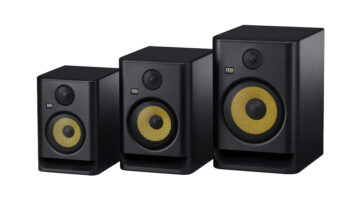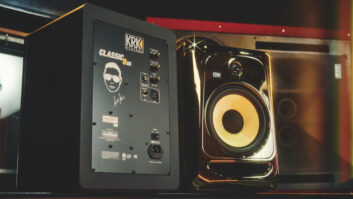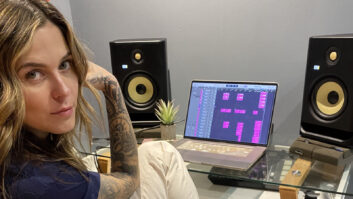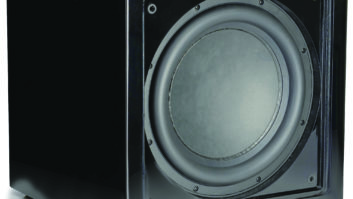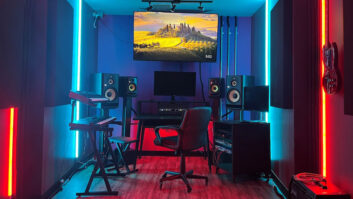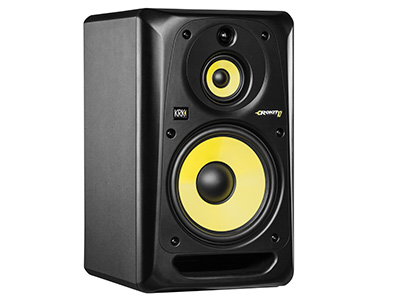
KRK, now owned by Gibson, has revamped the Rokit line of speakers to include two new models: the Rokit 4 two-way, and the largest of the series, the Rokit 10-3 G3, tested here.
This third-generation 10-3 features a 1-inch soft-dome tweeter, 4-inch midrange driver and a 10-inch glass-Aramid composite woofer. The tri-amped system offers 148 watts of total power with 30W going to the tweeter, 32W for the midrange, and 86W of low-frequency power. All of this power brings 110dB of SPL, which is plenty for most applications.
The front-ported, magnetically shielded MDF cabinets weigh 26.5 pounds and are 14.4×12.8×21.5 inches, so a sturdy and sizable stand is recommended for midfield use. Inputs are balanced XLR and TRS, or an unbalanced RCA. Other rear-mounted controls include system volume (-30 dB to +6 dB); high-frequency level (-2 dB, -1 dB, 0, +1 dB); and low-frequency level (-2 dB, -1 dB, 0, +2 dB). The midrange/tweeter module can be rotated so the speakers can be oriented on their sides.
Into My Studios
I’ve been using KRK speakers now for at least 20 years, and the new Rokits are a great addition to the KRK family. They feature a full-bodied sound from top to bottom, both loud and soft. When I first got the pair, I set them up in my home studio. I have a tight setup, and my desk is small and close. I used them at a low level most of the time and could hear the clarity of the highs and the bass at a decent level. I had to stand up and move back a few feet to hear them at a properly loud level.
Next I took them to Blackbird Studios here in Nashville where they sat on top of an API Legacy Plus console. I spread them out and also had another set of speakers that I often use in the studio. This was not such a fair test because they both sounded different in their own ways, but the 10-3 G3s held up pretty well. I might add that the other speakers were about $4,000 more than the 10-3 G3s and didn’t sound that much better.
The 10-3 G3’s top end is smooth and not brittle, and the bottom end is tight. Two things that I found lacking are punch and power when compared to my other speakers. I had both EQ settings on the back at normal, and the level knob was turned up halfway. I estimate that they were shy in the lower midrange from around 250 Hz up to around 1 kHz. The 10-3 G3s sounded a bit softer in those areas than what I’m used to. Also, because of their size, when you put them on top of a console, you, the listener, are just about level with the woofer, meaning you need to stand to be level with the tweeter and hear them properly. This is where the optional side orientation would work very well.
Conclusions
I think the Rokit 10-3 G3 would work great in a home or professional studio if they sat on stands that could get low enough so the tweeter would be at ear level, or in their optional side orientation. For the price, they are incredible, and I’m sure you will love them! n
TRY THIS
When placing larger midfield monitors on a console-top, experiment with orienting the monitors on their sides with tweeters in, then tweeters out. Depending on the size of the room and the distance of the speakers from the listener, the results can be remarkably different. Pick the orientation that gives you the best stereo picture from your listening position.
Product Summary
COMPANY: KRK Systems
PRODUCT: Rokit 10-3 G3
WEBSITE:krksys.com
PRICE: $499 each
PROS: Rotating midrange module allows for side orientation.
CONS: A bit shy in the 250 Hz to 1 kHz range.
Steve Marcantonio is a Grammy Award–nominated, Nashville-based engineer who has worked with Vince Gill, Reba McEntire, Taylor Swift, Band Perry and Thomas Rhett. He was voted Top Engineer at the 2007 ACM Awards.
